THESE DAYS, FROM MOST CORNERS of the fermented beverages business, you hear a lot of commentary about—and against—the concept of Dry January. It’s something the wine writer Miquel Hudin described recently as a “miserable celebration of abstinence” that, when this year’s calendar rolled into February, got left behind “like the desiccated corpse that it is.”
I enjoyed the colorful language, though the sentiment struck me as a bit dark. Our industry seems lately to be caught in a grip of fear that skipping a month of wine, beer, or cocktails is the gateway to teetotaling for the eleven that follow, particularly when it comes to twenty- and thirty-somethings’ habits. But I’m not losing too much sleep over it, consumption data about imbibers younger than I am notwithstanding. Wine and other fermented beverages have been around forever; in modern times, the attendant ebbs and flows to their popularity are subject to the need to constantly grow the industry around their production. “There isn’t any great statistical evidence yet that young adults have altered their drinking habits on a grand scale,” health correspondent Amanda Mull wrote in The Atlantic in 2019. “Many Millennials,” she guessed, “might just be tired of drinking so much.”
In the nearly five years since Mull’s article ran, which of course includes the roller coaster aftermath of Covid, the teetotalers definitely seem to have gathered steam. But in that same time, older millennials have (let’s hope) aged into a more wine-appreciative phase. I’m ever the optimist about it.
Whatever the reality, in my opinion it’s not a terrible, personal health decision to give one’s liver (and other organs) an annual month’s respite—be that January or, as my old wine importer friend Robert Hardy used to wink, the tidier 28 days February.
In my own history of Januarys, I think two of them have been dry. Maybe three. So whatever aspirations I had, as 2023 drew to a close, to add another to this small collection of wine/beer/cocktail-free months, they went out the window a few days after Thanksgiving when the boss asked me to fill in for him on a work trip to New Orleans. If there’s an abstinence-killing city in the U.S., it’s got to be The Big Easy, where folks of all age groups are clearly not tired of drinking so much.
Over the years, I’ve traveled many times to southern states, from Texas to Virginia and most major cities in between. My New Orleans visit last month was my first, and I didn’t want to go into it blindly. For advice, I got in touch with another old friend, Marc Domres, whom I’ve known since college and was a longtime resident of the city.
Marc started law school at Tulane University in 2002 and graduated just ahead of Hurricane Katrina three years later. Undaunted by the flooding damage to the Mid-City home he and his wife, Tracey, had purchased, they stayed in New Orleans for a total of 14 years before eventually returning to California. Knowing them both like I do—they’re a fun-loving couple who would probably anathematize the concept of any dry month—I saw Marc as the right person to ask for ideas on where to go for food, drink, and music in his former hometown. He didn’t let me down.
First off, he advised me, at some point during my visit I had to have a po’boy or a muffaletta sandwich (more on this later); second, I needed stay in the French Quarter. So I reserved a room at the Chateau LeMoyne on Dauphine Street—aka the Holiday Inn-French Quarter (this IHG member couldn’t help himself: the points might come in handy sometime in the future).
When I arrived, a placard in the hotel lobby informed me that the property was a very old Louisiana landmark, purchased and laid out in June of 1776, just a couple weeks before the signing of the Declaration of Independence. The building, however, was much newer, its early 1970s masonry constructed (convincingly, to my eye) to resemble its predecessors and blend into the French Quarter’s historic architecture. Nearly everything around it in the Vieux Carré, or “old square,” as the French founders of New Orleans called the Quarter, appeared truly old, history being as intrinsic to this neighborhood near the banks of the Mississippi River as any centuries-old section of Boston, New York, or Philadelphia.
On my first full day in town, I passed a corner bookshop near the hotel, Crescent City Books, and poked my head into it with the idea to pick up something about New Orleans history. The selection in the cramped shop was a little overwhelming. One title, Inventing New Orleans: Writings of Lafcadio Hearn, caught my attention, mostly for its 19th century subject’s unusual name.
“I find much to gratify an artist’s eye in this quaint, curious, crooked French quarter, with its narrow streets and its houses painted in light tints of yellow, green, and sometimes even blue,” Hearn wrote in an 1877 essay, “At the Gate of the Tropics,” one of many selected by the book’s editor, S. Frederick Starr.
The semi-obscure, Greek-Irish journalist arrived that same year in New Orleans. His essay was an introduction for readers to the city’s oldest section and drew a picture that hadn’t seemed to have changed much in the nearly 150 years since he wrote it. “Solid wooden shutters, painted a bright grass-green, and relieved by walls painted chocolate color, or tinted yellow, have a pretty effect, and suggest many memories of old France. Few houses in the quarter are without them.”
I’m not an artist, but I still found visual gratification around almost every corner in the neighborhood: at street level, locked gates leading down dark passageways to courtyards and semi-hidden gardens; overhead, the intricate—and iconic—wrought iron balconies girding countless buildings; purple, green, and gold Mardi Gras decorations hanging off of doors and in windows (I even saw a Christmas tree in one of them, painted white and decked out in those same New Orleans colors to bridge the gap until Fat Tuesday); and across the Quarter, Hearn’s shuttered windows on nearly every façade. What, I found myself wondering as I strolled up and down the old rues—Toulouse, Chartres, Bienville—was behind those solid wooden shutters?
For all of the interesting stuff to look at, it was the street music—the Dixieland jazz—that really grabbed my attention. The seeing was great, sure, along with the eating and drinking: New Orleans-y things I’d been hearing about for most of my life. A plenitude of excellent restaurants and bars, along with the colorful people working in them, left no question in my mind about what appeals most to visitors. For outsiders like myself, food and drink almost over-contribute to the definition of New Orleans. Though, after just a day or two working with my wine salesmen friends Randy Hanning and Erik Christensen, Louisiana natives whose job it is to feed into that culinary pipeline, it became clear to me how seamless the contribution actually is. But jazz music, a thing that missed the time Lafcadio Hearn spent in the city by just a couple of decades, is elemental to it.
In the evenings, especially from the bars along Bourbon Street a block away from the LeMoyne, the steady blare of guitar rock and hip hop was hard to miss. My preference was the daytime soundtrack around the Quarter, which was all Dixieland: trombones, guitars, banjos, drums, an occasional tuba. It was music to entertain visitors and locals alike and, I’d guess, a point of pride for the latter.
In a section titled “A New Orleans Jazz History” on the National Park Service website, it notes that an early trombonist named Tom Brown “took his band from Dixieland to Chicago at the invitation of a talent scout who heard them on the sidewalks of the Vieux Carré.” That was way back in 1915, though it could have described the street ensembles I stopped to listen to—there were a bunch of them—only several weeks ago. They were lively, sometimes gritty, little performances that must have connected back to an earlier time in New Orleans. For all I knew, there were still talent scouts combing the sidewalks of the Quarter.
And the jazz history mention on the Park Service site makes sense to me: the French Quarter, along with Frenchmen Street in the neighboring Faubourg Marigny, is like one big musical park.
• • • • •
By Friday at the end of the work week, with most of said work accomplished, I was ready for a po’boy. Or a muffaletta. Definitely a Pimm’s Cup.
A couple of days earlier, accompanied by Erik, I’d visited one of America’s most famous restaurants. At Commander’s Palace, it was strictly a business drop-in on Dan Davis, the restaurant’s wine director. I followed Erik to a back door of this legendary place in the Garden District and found myself making a beeline through the busy kitchen—once the domain of Paul Prudhomme and Emeril Lagasse—to the wine cellar. It was just a restaurant kitchen. I’ve been in many others. But it still felt a little surreal.
“Recognizing that eight years is an eternity,” my friend Marc wrote in an email before I left on my trip, noting the time elapsed since he and Tracey had last lived in the city, “here are some of my recommendations.” He sent a list of several dining establishments, from casual to fancy, that they’d gone to up until 2016. Commander’s Palace was at the top of it.
Marc suggested it as a great place for a weekday lunch, and he added some editorial: “See if they will seat you in the Garden Room upstairs”—in fact visible across a courtyard from Dan’s cellar door—“get the special and have the 50 cent Cosmos. If you go for dinner it will cost $150 a head. Lunch is just as good for $50, and you’ll be drunk. Turtle soup is awesome.”
When I first read his email, I smiled at the miscommunication. A two (or more) Cosmopolitan lunch fell outside the normal parameters of a traveling workday for me (so, for that matter, did turtle soup). But, after being in town for less than 24 hours, I realized I was the one missing the point: in New Orleans, most people—the working folk and tourists, alike—appear to go bibulously through the day. I sort of just went with the flow all week.
That flow took me to Friday and the aforementioned Pimm’s Cup, recommended by yet another old friend, Gus Vahlkamp, a Kentucky transplant to California and an aficionado of New Orleans. Marc’s list of favorite places to eat dovetailed nicely with Gus’s own can’t-miss establishments in the French Quarter.
He texted me after I’d arrived to ask where I was staying and quickly figured out that the LeMoyne was a good location, just around the corner from Arnaud’s French 75 Bar. “Napoleon House is close by too, where you will want to have a Pimm’s Cup in the morning after coffee.”
You don’t know what you don’t know, as they say. But now I knew.
Late Friday morning was my best opportunity to check this fruity cocktail—one of several mixed drinks associated with New Orleans—off the list. I consulted Marc’s email again to map out a plan for lunch. The main question was: po’boy or muffaletta? I’ve got nothing against cold cuts and olive salad, but I felt more strongly at that moment about the former, which had always connected in my head to New Orleans.
Marc opined that, when it comes to po’boys, it’s “forever a debate between Domilise’s and Parkway Tavern” for the city’s classic sandwich—of which I discovered there are multitude combinations, including oyster, shrimp, chicken, roast beef, and even alligator. “I’m a Parkway man,” he added. “It has a better bar.”
I kept this in mind as I studied the map directions to each of Marc’s spots on my laptop screen. I’d be leaving the French Quarter on foot; the bar at Parkway Tavern was a good selling point, but Domilise’s Po-Boy & Bar won out. It would take me on a longer route through the Garden District, a part of the city I wanted to explore up-close after seeing it mainly through Erik’s car windows two days earlier.
Outside of the hotel on Dauphine Street a little before 11:00, I weighed the option of an adult beverage with lunch against one before it (the locals, no doubt, are unencumbered by such decisions). Gus had already chastised me via text for not yet checking out the French 75 Bar, so I decided to head straight to Napoleon House on the corner of St. Louis and Chartres.
Sliding onto a bar stool a few minutes later, I ordered a Pimm’s Cup and surveyed the eclectic scene: a checkerboard tiled floor, rustic wooden tables and chairs, and peeling paint on walls that displayed a gallery’s worth of framed artwork and photographs. Classical music came out of speakers somewhere, a low-key counterpoint to the lively Dixieland jazz everywhere else. Several tables were already full; a small group of Japanese tourists had walked in just ahead of me, but the crowd looked otherwise local.
While the January weather outside was mild and sunny, there was a wintry vibe inside Napoleon House, cozy and welcoming. It reminded me of old-school places I’d been, especially on cold winter days, living in Paris or visiting New York or London: effortlessly funky and unpretentious café-bars. Or, rather, plenty of effort had gone into just keeping them around for so long. “It is not an easy thing to describe one’s first impression of New Orleans,” Lafcadio Hearn wrote in his “Gate of the Tropics” essay, “for while it actually resembles no other city upon the face of the earth, yet it recalls vague memories of a hundred cities.”
The bar room is one of two, along with a courtyard, that take up the ground floor of one of the French Quarter’s most storied buildings. In “Dropping by the Napoleon House,” an article that ran in The Times-Picayune in 1986, the late New Orleans journalist Ronnie Virgets noted that, while historians have disagreed on some of the facts, there was a consensus that it was built by an early 19th century mayor of the city, Nicholas Girod.
“Around 1821,” Virgets wrote, “a group of Bonapartists reportedly met there to plan a rescue of the Little Corsican from exile on St. Helena. Girod’s home was to be used as a haven for the general, but Napoleon died before the plot could be launched.” And so an opportunity was lost for “a city that often sees itself as a prayer wheel of American history,” as the reporter described his home town, to add what would have been an extraordinary Little Corsican chapter to its own long and colorful history.
Virgets further observed of the building in which I found myself having a delicious Friday morning cocktail, “the fact that Napoleon Bonaparte would have even ‘thought’ about living there is enough to make a place socially acceptable.”
His article came out the same year I graduated from high school. It’s funny to me now, having come and gone from New Orleans, that it took me nearly four decades of adult life to finally make it there, drop by Napoleon House, and enjoy a socially acceptable Pimm’s Cup after my morning coffee.
I was about to pay for my drink when I noticed a stack of white plastic cups on the bar next to a tray of bitters and tinctures. They bore the logos “Napoleon House” and “Pimm’s” on each side. The bartender, a politely professional but otherwise non-chatty guy, saw me looking and probably read my thought. “Those are go-cups,” he said with a tiny hint of a smile, blowing the mind of another NOLA newbie, “in case you want to take one with you.”
Like I said about my first-ever week in the French Quarter and New Orleans, I just sort of went with the flow.
[End of Part One. Part Two—on po’boys, turtle soup, and the world’s greatest cocktail—coming soon.]
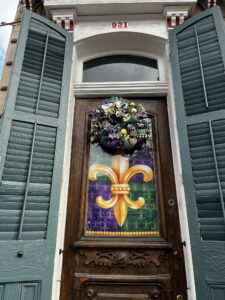

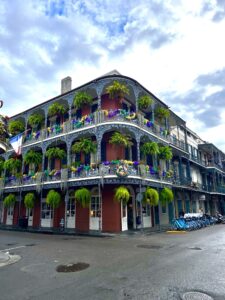

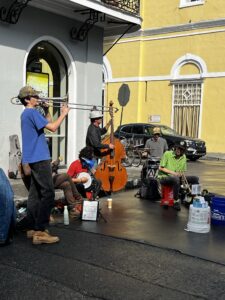
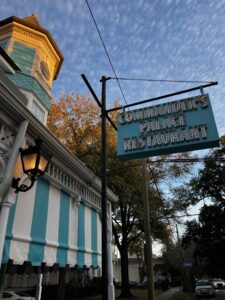


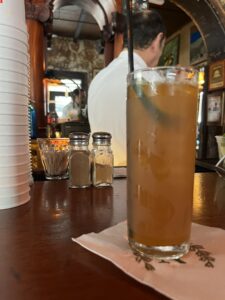


Well, I wish I was in New Orleans, I can see it in my dreams,
Arm-in-arm down Burgundy, a bottle and my friends and me